The BLS unemployment report shows total nonfarm payroll jobs gained were 171,000 for October 2012. September payrolls were revised from 114,000 to 148,000 and August was also revised upward, from 142,000 to 192,000. The below graph shows the monthly change in nonfarm payrolls employment.

The BLS employment report is actually two separate surveys and we overviewed the current population survey in this post. Between election rancor and pundit spin one can get dizzy with all of the statistical manipulations and economic fiction thrown about. We take a straight look at the jobs reported by businesses by the graphs, by the numbers and by the book.
The start of the great recession was declared by the NBER to be December 2007. The United States is now down -4.227 million jobs from December 2007, 4 years and 10 months ago.
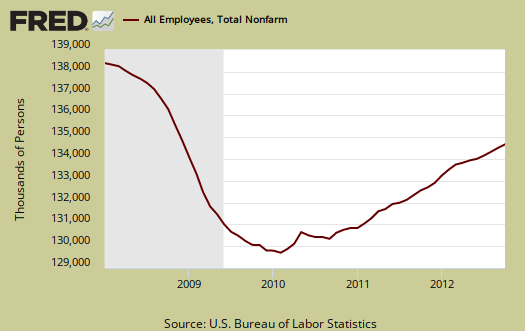
The below graph is a running tally of how many official jobs are permanently lost, from the establishment survey since Decemember 2007. Amazing isn't it considering the time period of the below graph.
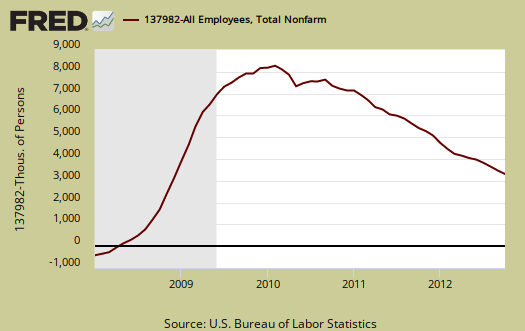
We broke down the CES by industry to see what kind of percentage changes we have on the share of total number of payroll jobs from 2008 until now. Below is the percentage breakdown of jobs by industry for January 2008.
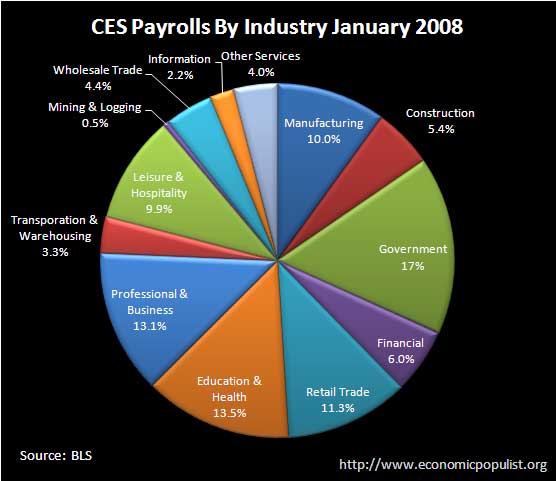
We expected to see construction jobs shrink relative to total payrolls and it did, by 1.3 percentage points. Notice the culprit of the recession, the financial sector, only shrank 0.2 percentage points as it's share of payroll jobs. Manufacturing, of which the auto industry is a part, has contracted an entire percentage point as share of total jobs. Not all of this is job loss, productivity increases and time marches on and some jobs become obsolete. These two pie charts make it painfully obvious our manufacturing sector continues to erode and the only real growth field is in health care. Not exactly a demonstration of America being a titan of industry.

From October of 2011, the United States has gained 1,595,224 million payroll jobs. In the year previous, the U.S. had gained 1,572,736 jobs. This tells us jobs have been growing at pretty much at the same pace for the last two years and it's simply not fast enough to employ the 12.3 million official unemployed, never mind the estimated 18-23 million Americans who really need a good job.
Just to keep up with population growth, we need at least 100,000 jobs per month or 1.2 million a year and this estimate assumes the current low labor participation rates. As we can see we're really breaking even on jobs at this point, almost five years since the start of the recession.
Private Sector jobs, or jobs not from the government gained 184,000, yet are still down -3,862 million jobs from December 2007. Below is a graph of just the private sector payroll losses since December 2007.

Manufacturing alone has lost -1.863 million jobs since January 2008. This month's increase was 13,000 manufacturing jobs.
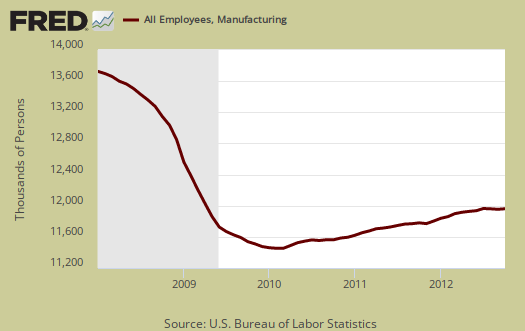
The motor vehicle industry has become political football, so below is the graph of autos, trucks & parts manufacturing jobs. We can see payrolls have been eroding for some time, and have not recovered from even the recession. This month the auto & parts manufacturing lost -2,100 jobs and since January 2008, the auto manufacturing industry is still down -170,800 jobs.

Government lost -13,000 jobs for October. That said, government, especially at the state and local level has been hemorrhaging jobs. Since January 2008, all government payrolls are down -365,000 jobs.
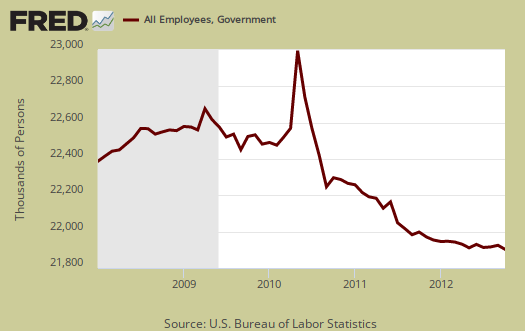
Construction has just been hammered due to the housing bubble collapse as well as the recession. This month construction gained 17,000 jobs yet from the beginning of the recession jobs in the construction field are down -1,942 million jobs.

Financial activities payrolls are now down -456,000 jobs since the start of the recession. This month the financial sector gained 4,000 jobs.

Retail trade, which are your retail sales outlets like big box marts, direct mailing and anything retailing merchandise, is down -739,300 jobs since the start of 2008 and this month gained 36.4 thousand jobs.

Education and health services has consistently been increasing and this month was no exception 28,000 additional jobs and of those jobs 32.4 thousand were in health care and social assistance, which implies education jobs were lost. A total of 1.835 million jobs have been gained in education & health services since the start of 2008.

Professional & Business services contains management, career professionals, science & technical, administrative and support and finally waste services. This industry sector is only down -44 thousand jobs since the start of the great recession and this month added 51,000 jobs, with 13,600 of them being temporary.

Transportation and warehousing also has still not recovered their jobs and are down -150,600 since January 2008. This sector has been losing jobs for recent months with October's gain being a measly 1,000. These are services for moving of people as well as cargo and also storage.

Pundits and amateurs try to spin the employment report and this month it's on fire. What we have is another treading water employment report, which is certainly better than drowning, but not exactly providing enough jobs for America's citizenry.
Here is last month's CES overview, only graphs revised but with more details, links to more tables, information on BLS benchmarks, which were not incorporated in this overview.

the claim that private payrolls has recovered is false
I saw a post which claimed private payrolls has recovered their jobs lost from the recession. That is false. It is also statistically manipulative to pull out industrial sectors such as construction and manufacturing to make private payrolls "recover".
That statement is also false because it does not take into account increased population and jobs needed for the increased population of working age.
We do our best to not manipulate government statistics, yet shine a light on what's going on and I find such parlor tricks really unethical.